Book contents
- Frontmatter
- 1 Background, Sources, and Methods
- 2 The Early Bronze Age in Greece
- 3 The Early Bronze Age in the Cyclades
- 4 Early Prepalatial Crete
- 5 Protopalatial Crete
- 6 The Material Culture of Neopalatial Crete
- 7 Minoan Culture: Religion, Burial Customs, and Administration
- 8 Minoan Crete and the Aegean Islands
- 9 Minoan Trade
- 10 Early Mycenaean Greece
- 11 Mycenaean Art and Architecture
- 12 Mycenaean States
- 13 Burial Customs and Religion
- 14 Mycenaean Greece, the Aegean and Beyond
- 15 Decline, Destruction, Aftermath
- Glossary
- Select Bibliography
- Index
- Plate section
11 - Mycenaean Art and Architecture
Published online by Cambridge University Press: 28 November 2010
- Frontmatter
- 1 Background, Sources, and Methods
- 2 The Early Bronze Age in Greece
- 3 The Early Bronze Age in the Cyclades
- 4 Early Prepalatial Crete
- 5 Protopalatial Crete
- 6 The Material Culture of Neopalatial Crete
- 7 Minoan Culture: Religion, Burial Customs, and Administration
- 8 Minoan Crete and the Aegean Islands
- 9 Minoan Trade
- 10 Early Mycenaean Greece
- 11 Mycenaean Art and Architecture
- 12 Mycenaean States
- 13 Burial Customs and Religion
- 14 Mycenaean Greece, the Aegean and Beyond
- 15 Decline, Destruction, Aftermath
- Glossary
- Select Bibliography
- Index
- Plate section
Summary
Introduction
The culture of the Mycenaean Greeks can best be accessed through the tangible record they have left of their life and death in the four centuries from their emergence as a power at the end of the Middle Helladic period to the destruction of their palaces at the end of Late Helladic IIIB. Schliemann’s first great archaeological discoveries at Mycenae in 1876 named both the civilization and the age of its supremacy. The great amount of gold in the deeply buried shaft graves immediately captured the world’s attention, particularly the gold face masks. In one of these Schliemann thought he had looked upon the face of Agamemnon. Archaeologists now know that the early date of the graves precludes such an identification and we no longer equate these finds with things mentioned in Greek legends and the epics of Homer. We realize that oral tradition and subsequent literature have many components, only some of which may carry memories or preserve details of the Mycenaean world - after all, the time span between the shaft graves and the Parthenon exceeds a thousand years. The decipherment of the Linear B texts as Greek in 1952 (Ch. 1, pp. 11–12) opened another window into the culture but, because of their limited subject matter, we are left without discussion of some of the most important aspects one would wish to know about a society. So the material remains provided by archaeological endeavors since 1876 are the primary source for our understanding of Mycenaean culture.
- Type
- Chapter
- Information
- The Cambridge Companion to the Aegean Bronze Age , pp. 258 - 288Publisher: Cambridge University PressPrint publication year: 2008
- 4
- Cited by

